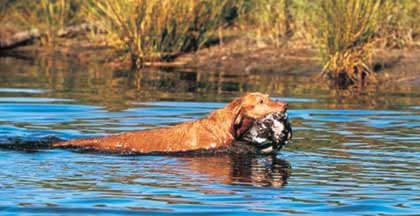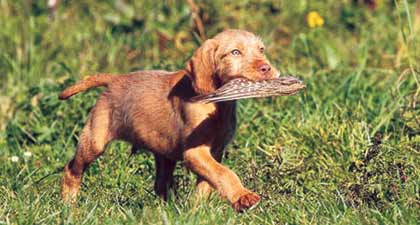The number of retriever breeds plying their trade in America has been quite stable for at least a century. Ditto for the number of spaniel breeds. However, the number of pointing breeds gliding through our national scenery has increased rather frequently. Why this is, or what it suggests about folks who prefer to have their birds pointed, is beyond me. However, as an all-sporting breed aficionado, I am most grateful for the series of fascinating pointing breeds that have arrived here during my lifetime.
The most recent to come to my attention is the wirehaired vizsla (WHV). This is a relatively new breed, originating in Hungary during the 1930s. Any breed lacking a many-centuries-long history—perhaps tracing back to certified canine passengers on Noah's Ark, or at least to King Tut's kennels—is at a disadvantage here in the Colonies. To make the American team without such credentials, a breed needs not only a lot of natural talent but also an "extra something" that makes it stand out from other talented pointing breeds.
The WHV has all of the above. Talent? This breed is easy to train, hunts close, is a good bird-finder, retrieves naturally and tenderly, takes readily to waterfowl retrieving in all but severe conditions, and has even proved its worth in falconry. Its "extra something?" The WHV has charm in abundance.
History
In the mid-1930s, Vasas Jozef of Csabai Vizsla Kennel in Hungary, set about to develop a new breed with the hunting traits of the vizsla but with a wirehaired coat for better protection from cold weather and punishing cover. He decided to cross his vizslas with German wirehaired pointers, so he teamed up with Gresznarik Lazlo of de Salle German Wirehaired Kennel. After the usual disappointments and near-misses, they achieved their goal with a bitch they named Dia de Selle, the first WHV to be exhibited.
She wasn't perfect, in that her coat wasn't quite as thick and rough as they wanted, but she was close enough to become the wirehaired vizsla breed's foundation bitch. In 1943 the Vizsla Club of Hungary began assisting in the development of this new breed. Because of WWII and post-war problems in Europe, it wasn't until 1966 that the Federation Cynologique Internationale (FCI) recognized the wirehaired vizsla as a separate Hungarian breed.
WHVs were introduced into the United Kingdom in 1970, and from thence into Canada. The Canadian Kennel Club (CKC) recognized the breed in 1978. In the early 1970s, Mr. Charles Newman of Volney, Virginia began importing and breeding them, but he called the breed the "Uplander." In the ensuing years, the name happily reverted to wirehaired vizsla, and in 1986 the North American Versatile Hunting Dog Association (NAVHDA) recognized the breed under that name. Although still a rare breed, a few WHVs have done well in NAVHDA tests. The United Kennel Club (UKC) recognized the breed in 2006.
In 2003, a group of WHV fanciers formed a national breed club, the Wirehaired Vizsla Club of America (WVCA) and a quarterly newsletter ("Hot Off the Wire!"). The club's leadership is developing a working certificate test program, and they plan to sponsor annual national specialties. The breed is now recognized by the American Kennel Club (AKC).
 A true versatile hunting dog, the wirehaired vizsla will also retrieve from water. (Ron Baltus photo) |
This highly talented breed is ideally suited for today's American all-around hunter and is supported by a loyal and dedicated group of breeders and owners. Thus, the breed's future in this country should be quite promising.
Physical Description
The wirehaired vizsla is an average-sized pointing breed. The males typically stand 23 to 25 inches at the withers and weigh 55 to 60 pounds. The females stand 22 to 23.5 inches and weigh 50 to 55 pounds. The tail is docked by about one-fourth or one-third. Because of the German wirehair influence, the WHV is somewhat heavier boned than the vizsla.
The coat comes in the same range of colors found in the vizsla, varying from a sandy gold to a russet gold. It is a double coat, having a soft undercoat for warmth and a harsh, wiry outercoat for protection.
This coat picks up burrs, but not like breeds with long, soft coats. Because of the wiry outercoat, the breed has pronounced eyebrows and whiskers, which contribute to its striking appearance.
Temperament
This is a soft breed, an affectionate breed, a people-loving "everybody's buddy" breed. A natural charmer, it gets along well with family, friends, strangers, other dogs, other family pets, and children (known and unknown). Beyond barking to announce stranger's presence, the typical WHV is a total washout as a watchdog.
"My elderly mother lived with us during her last few years," said WHV breeder Deb Wall of Konza Vadasz Kennel in Assaria, Kansas, "and she suffered several strokes." "All of our WHVs were very careful not to bump her or get in her way. One, named Tulip, practically adopted Mom. She slept by Mom's bed and if Mom got out of bed and became disoriented, Tulip would come into our bedroom, nuzzle my face until I woke up, and then lead me to Mom."
"In our hunting and fishing lodge," said Mike Kinsella of Border View Lodge in Baudette, Minnesota, "we couldn't have a dog that didn't get along well with all sorts of people. Our WHV is a very charming host to one and all. And our hunting clientele love to hunt with him."
"Before we got 'CB,' our first WHV," said David Nackerud of Portland, Oregon, "my wife Susan had never been around dogs. But she has become so attached to CB and to this breed that she says we'll never be without one."
Training
Being soft, the WHV is easy to train, if and only if you use a gentle approach. The WHV has a strong desire to please and will do anything you want him to do, provided only that he understands what it is you want. If he fails in some way, it's almost certainly because he doesn't understand what he's supposed to do.
He's not being rebellious; he's not testing your limits; he just doesn't understand. Therefore, you should train a WHV with predominantly positive techniques and minimal corrections. In fact, that's the only way you can succeed in training one. Over-corrected, a WHV tends to shut down. Over-corrected repeatedly, he might not ever open back up.
"I've abandoned the e-collar," said David Nackerud. "I just don't need it with my WHV. A voice correction is all she ever needs."
 Wirehaired vizsla puppy retrieving a bird wing. (Ron Baltus photo) |
All this means that training a WHV takes more time, more patience, and more thought than training a tougher breed. However, the WHV is so cooperative, so appreciative and such a buddy that you'll enjoy the extra time and effort this takes...that is, unless you're a tough, hard-boiled individual who wants quick results at all costs. If that's the case, do yourself and the WHV breed a favor by looking elsewhere for a dog.
Like most soft breeds, the WHV retains his training very well. You won't have to re-train him at the start of every hunting season. He wants to please you and he'll remember what that required last year. Incidentally, being such a people-loving animal, WHVs need to spend a significant amount of time in the house with the family. Left in an outside kennel run all the time, they don't develop properly. Think of their time in the house as "training time" as well as leisure, for the bond the dog makes with his people while in the house contribute significantly to the success of his training.
"If they don't get to interact frequently with their people," Deb Wall said, "they become bored, and eventually turn manic and neurotic. Sure, they can eat and sleep in a kennel run, or be confined there while the family is at work, but left in a kennel run 24/7? No, definitely not."
Besides, being calm and laid-back, not "wired" (please pardon the awful pun), they are pleasant companions around the house. Then, too, they accept your "house rules" most graciously.
Hunting Niche
For a typical WHV, any critter wearing feathers is fair game. They're very birdy, and they have a strong pointing instinct. They retrieve naturally, sans force-breaking, and they take readily to water. Here and there, a falconer uses a WHV in his sport. Upland gamebirds, of course, are their favorites. In upland hunting, they have more endurance than slash and dash. They won't electrify the horseback field trial set by hunting the horizon and beyond.
They tend to hunt close to the boss, always anxious to stay in contact with him. They don't point with the "high on both ends" loftiness expected in field trials, but the do lock up rigidly, leaving no doubt that they've found birds, which is more than enough style to delight most hunters. Like other versatile breeds, they have good noses, and with a couple years of experience, they can develop uncanny bird sense. And at their relaxed pace, they can go all day, day after day.
Hunting with such a dog can be a very personal, a very memorable experience. "I'd grown immune to hunting," said Mike Kinsella, "because it's part of my work here at the lodge. But since I got my WHV, Zeke, I've developed an enthusiasm for hunting like I've never had before, not even years ago when I got my first dog. I'm actually disappointed when a guest wants to hunt with my flusher instead of Zeke."
"My WHV hunts within about 50 yards of me," said David Nackerud, who hunts all the various gamebirds found in the Northwest. "He handles runners quite well, relocating as often as necessary, pointing staunchly each time the bird stops. He retrieves naturally and with a very soft mouth."
Deb Wall, who hunts mostly quail and pheasants in Kansas, said that her WHVs hunt within about 100 yards, are very biddable and retrieve naturally.
The typical WHV takes easily to water and waterfowl hunting. In fact, WVCA intends to include water tests in their forthcoming working certificate program. Being a relatively calm breed, WHVs find it easy to relax in the blind during the long quiet spells between spurts of fast action. They especially enjoy the close camaraderie with the boss and his hunting buddies that sitting together in a blind offers them.
Can they withstand extremely cold water like a Chesapeake? Of course not! The WHV is a generalist, not a specialist in any of his varied lines of work. Deb Wall answered the cold weather waterfowling question quite well: "My WHVs can handle it better than I can. I'm always ready to go in before they are."
Deb Wall also told me that she has sold WHV pups to falconers, who use pointing dog to locate and flush birds (on command) for their falcons to catch. Then, when the falcon is on the ground with its prey, the dog stands guard to protect it from predators. Falcons don't get airborne easily from the ground so are quite vulnerable there.
In summary, the WHV is a generalist. He can't run with field trial pointers. He can't break ice all day with a Chesapeake. But he can do everything the all-arounder, that is, the hunter who pursues whatever is in season, wants done, and he can do it very well.
The WHV hunts close (with and for you), has an excellent nose, retrieves naturally and takes readily to water work under reasonable conditions. And, when not working in the field, he's a charming family member.






